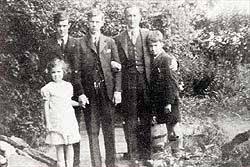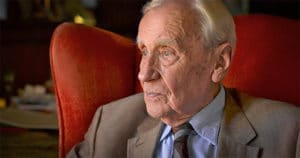
Imagine being a child, listening with your siblings to bedtime stories about Bilbo Baggins, or being enchanted at Christmastime as your father read the latest installment in the Father Christmas letters, featuring the antics of Polar Bear. Then imagine being that child at five years old and grasping enough to point out inconsistencies in your father’s stories. Or being a young man in your 20s, and joining the likes of J.R.R. Tolkien, C.S. Lewis, Owen Barfield, and others for a weekly pint at the pub — participating in one of the most famous literary discussion groups of the 20th century.
Perhaps it’s no wonder that J.R.R. Tolkien (1892-1973) eventually chose his youngest son, Christopher Tolkien (1924-2020), as his literary executor. An academic and writer in his own right, Christopher would preserve and extend his father’s legacy for nearly 50 years after the author of The Hobbit and The Lord of the Rings died. It is because of Christopher’s dedication to this task that we have The Silmarillion, The Fall of Arthur, The Fall of Gondolin, Beren and Luthien, The Children of Hurin, The Lay of Aotrou and Itroun, and many other stories and tales.

J.R.R. Tolkien with his children in the 1930s. Christopher is at right.
Christopher died last week (Jan. 15) at his home in France. Last year, with the publication of The Fall of Gondolin, he’d announced that he was retiring from publishing. He’d completed the major publications he needed to do as his father’s executor, the totality of which his father called the “legendarium.” Christopher was the editor of that legendarium.
We see how relatively short many of the tales are, in comparison to an epic like The Lord of the Rings, and we might question what took him so long. We shouldn’t. Christopher performed some of the most difficult editing work imaginable.
Medieval scholar John Bowers, author of the newly published Tolkien’s Lost Chaucer, notes six difficulties posed by J.R.R. Tolkien’s manuscripts. His handwriting ranged from neat to unreadable. He was constantly making changes across different versions, and sometimes you had to guess which were the final ones. He kept everything, except old drafts he thought no longer needed. Many manuscripts and notes were undated. Materials were often piled together but in no discernible order. He’d often pull sections of a manuscript from where it belonged for another purpose, like a lecture, and forget to return it.
And add one more: Tolkien was famous for starting projects and not finishing them, or starting them over from scratch, leaving multiple versions in various stages of completion behind. Christopher had to be a literary detective as often as he was an editor. It’s a measure of the father’s prodigious output, and the son’s dedication and grasp of his father’s work, that some 23 works were published after his father’s death in 1973, both major efforts like The Silmarillion and translation of Beowulf as well as the shorter tales like The Fall of Gondolin. (See the blog A Pilgrim in Narnia for a complete list.)

Christopher Tolkien
In addition to catching inconsistencies, Christopher made another significant contribution to his father’s works while J.R.R. was still alive: he drew the original maps of Middle-earth for The Lord of the Rings. His father had drawn his own maps, with some of the same problems as his manuscripts, and Christopher had to make sense of often conflicting versions.
He was the third child of J.R.R. and Edith Tolkien, born in Leeds in 1924 while his father taught at the university there (in 1925, J.R.R. became Professor of Anglo-Saxon at Merton College, Oxford). He had two older brothers, John and Michael, and a younger sister, Priscilla. In 1943, at age 18, he joined the Royal Air Force. After the war, he studied English at Trinity College, Oxford, eventually getting two degrees. In 1960, he published The Saga of King Heidrik the Wise (translated from the Icelandic). From 1964 to 1975, he was a tutor and lecturer at New College, Oxford.
Christopher married twice. The only child from his first marriage is Simon Tolkien, a lawyer and novelist. Christopher disowned Simon when Peter Jackson began filming the movie versions of The Lord of the Rings. Christopher and the Tolkien estate refused to cooperate with the movie project, while Simon broke ranks and cooperated with the filming. The two were estranged for years, but they did eventually reconcile. Christopher had two more children, a son and a daughter, from his second marriage.
We owe Christopher Tolkien a great debt. Yes, the works published by J.R.R. Tolkien in his own lifetime were certainly a sufficient achievement. The Lord of the Rings has been called the greatest work of literature of the 20th century. But without Christopher, we wouldn’t have known his father’s full achievement, the phenomenal imagination that led to wonderful stories and invented languages like Elvish, and all of the work he did that contributed to what we knew but sat in files and family archives. Christopher showed us the full literary legacy of his father, and gave us some wonderful stories in the process. We know the extent of the legendarium because Christopher unlocked its door.
Related:
The Abounding Creativity of Middle-Earth: An Appreciation of J.R.R. Tolkien
The Last of the Tolkien Tales: “The Fall of Gondolin”
A New Exhibition: Tolkien and the Making of Middle-earth
“The Fall of Arthur” by J.R.R. Tolkien
Tales of the First Age: “Beren and Luthien” by J.R.R. Tolkien
“The Children of Hurin” and “The Lay of Aotrou and Itroun” by J.R.R. Tolkien
Poets and Poems: J.R.R. Tolkien and “Beowulf”
Photo by Christopher Combe, Creative Commons, via Flickr. Post by Glynn Young.
__________________________

“I require all our incoming poetry students—in the MFA I direct—to buy and read this book.”
—Jeanetta Calhoun Mish
- “Your Accent! You Can’t Be from New Orleans!” - October 9, 2025
- Poets and Poems: Donna Vorreyer and “Unrivered” - October 7, 2025
- Poet Sidney Lanier and the Lost Cause - October 2, 2025
Bethany R. says
Fascinating. Thank you for filling us in a bit on the challenge Christopher Tolkein took on and what he accomplished. I adore Lord of the Rings and am working my way through The Silmarillion.
Katie says
Glynn,
Your fifth paragraph, beginning with “Medieval scholar. . .” and ending with “. . .and forget to return it.” This description off Tolkien’s lack of organization got my attention and should give any parent hope that a person can contribute greatly even if they are not as organized as the “educational experts” would have one believe you must be in order to be successful.
Katie
Bethany says
Yes, that encouraged me as well, Katie. 🙂
Sandra Heska King says
“We know the extent of the legendarium because Christopher unlocked its door.”
Confession: I’m not well schooled in Tolkien. I have a set of books, and I *did* see one of the movies and then vow to read. But haven’t. Middle Earth does not appeal to me as a place to hang out. Sunday, though, the door was part of the sermon, and now I assume that’s what you are referring to. Maybe these are signs that I should change my ways.
Will Willingham says
“Then imagine being that child at five years old and grasping enough to point out inconsistencies in your father’s stories.” This is the part I’m stuck at. A 5-year-old editor in development.